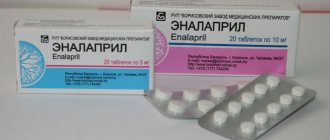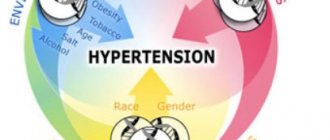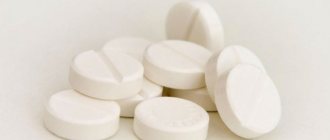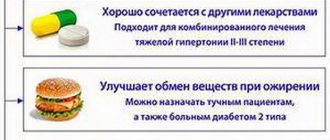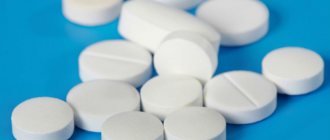Lisinopril: active ingredients
The name of the drug is identical to its active substance - lisinopril dihydrate. Separately, you can find the drug under other trade names. As a rule, its cost under other names is significantly higher.
The following can be used as auxiliary components by various manufacturers:
- corn starch or pregelatinized;
- calcium hydrogen phosphate;
- mannitol;
- magnesium stearate;
- colloidal silicon dioxide;
- microcrystalline cellulose;
- talc.
The drug is produced in the form of oblong white tablets. Its edges are rounded and there is a risk in the center. Each tablet contains 5 mg, 10 mg or 20 mg of active ingredient. The medicine is packaged in 10 tablets in a blister. The package contains 30 doses (3 blisters).
How does Lisinopril work?
The drug acts on the renin-angiotensin system of the heart, interfering with dilatation of the left ventricle. At the same time, there is a decrease in the load on the myocardium. The substance reduces pressure in the capillaries of the lungs, as well as in peripheral vessels. When treated with Lisinopril, the tolerance of the cardiac myocardium to increased stress increases. In addition, the activity of renil in plasma increases.
After taking a single dose, the first positive effect occurs after 50-60 minutes. The manifestation of the therapeutic effect intensifies within 7 hours and persists throughout the day. Therapy lasting for several weeks achieves the maximum possible hypotensive effect.
Eating does not interfere with the absorption of the active substance, but at the same time does not contribute to it. Therefore, taking the medicine does not depend on the time of eating. Absorption of Lisinopril reaches 25%. The drug molecules bind weakly to blood proteins. Half-life occurs after 12 hours. Substances are excreted unchanged by the kidneys. Lisinopril does not form metabolites.
Interactions of the drug Lisinopril-ratiopharm
Alcohol, diuretics and other antihypertensive drugs (α- and β-adrenergic receptor blockers, calcium antagonists, etc.) potentiate the hypotensive effect of lisinopril. When used simultaneously with potassium-sparing diuretics (spironolactone, amiloride, triamterene), hyperkalemia may develop, therefore, when using these drugs, it is necessary to monitor the concentration of potassium in the blood plasma. Hyperkalemia is also possible with the simultaneous use of cyclosporine, potassium supplements, and nutritional supplements containing potassium, which is of particular importance for diabetes mellitus and renal failure. NSAIDs (especially indomethacin), sodium chloride reduce the antihypertensive effect of lisinopril. When used with lithium preparations, there may be a delay in the excretion of lithium from the body and, accordingly, an increase in the risk of its toxic effect. It is necessary to constantly monitor the level of lithium in the blood. Bone marrow depressants combined with lisinopril increase the risk of neutropenia and/or agranulocytosis. Allopurinol, cytostatics, immunosuppressants, corticosteroids, procainamide, when used simultaneously with lisinopril, can cause the development of leukopenia. Estrogens and sympathomimetics reduce the antihypertensive effectiveness of lisinopril. Lisinopril-ratiopharm can be used simultaneously with glyceryl trinitrate, which is administered intravenously or transdermally. Prescribe with caution to patients with acute myocardial infarction for 6–12 hours after administration of streptokinase (risk of hypotension). Lisinopril-ratiopharm enhances the manifestations of alcohol intoxication. Narcotics, anesthetics, sleeping pills, tricyclic antidepressants enhance the hypotensive effect. When performing dialysis during therapy with lisinopril, there is a risk of developing anaphylactic reactions if high-flow polyacrylonitrile metalsulfonate membranes (for example AN69) are used. Hypoglycemic oral drugs (for example, sulfonyl urea derivatives - metformin, biguanides - glibenclamide) and insulin when used with ACE inhibitors can enhance the hypotensive effect, especially at the beginning of treatment. Taking antacids may reduce the hypotensive effect.
What is lisinopril prescribed for?
The name of the drug suggests that it belongs to the so-called group of “by-catch”, the action of which is primarily aimed at lowering blood pressure in the fight against hypertension. However, a doctor may prescribe treatment with Lisinopril in other cases:
- for chronic heart failure;
- in acute myocardial infarction not accompanied by arterial hypotension;
- to combat nephropathy of diabetic etiology, both type 1 and type 2.
- with arterial hypertension.
Self-administration of the drug is unacceptable. The dose, frequency of doses and duration of treatment are determined only by the doctor.
Possible side effects
Like other medicines, lisinopril can cause side effects, although not everyone gets them.
Tell your doctor immediately if you notice any of the following effects.
- Severe allergic reactions (rare, affecting 1-10 in 10,000 people).
Symptoms may include sudden onset:
- Swelling of the face, lips, tongue, or throat. This may cause difficulty swallowing.
- Severe or sudden swelling of the arms, legs, and ankles.
- Difficulty breathing
- Severe itching of the skin (with blisters).
- Severe skin problems such as a sudden, unexpected rash or burning, redness or peeling of the skin (very rare, affecting less than 1 in 10,000 people).
- Infection with symptoms such as fever and severe deterioration of general condition, or fever with local symptoms of infection such as sore throat/pharynx/mouth or urinary problems (very rare, affecting less than 1 in 10,000 people).
Other side effects:
Common (occurs in 1-10 out of 100 people)
- Headache
- Feeling dizzy, especially when standing up suddenly.
- Diarrhea
- Dry cough that doesn't go away.
- Vomit
- Kidney problems (confirmed by a blood test)
Uncommon (occurs in 1-10 out of 1,000 people)
- Mood changes
- Change in color of fingers or toes (pale blue accompanied by redness) or numbness or tingling in fingers or toes.
- Change in taste sensations
- Drowsiness
- Dizziness (vertigo)
- Sleep problems
- Stroke
- Cardiopalmus
- Runny nose
- Nausea
- Abdominal pain or indigestion
- Skin rash or itching
- Lack of erection (impotence)
- Feeling tired or weak (loss of strength)
- Excessive low blood pressure may occur in people with the following conditions: coronary heart disease, narrowing of the aorta (heart artery), renal artery, or heart valves; increase in the thickness of the heart muscle. If this happens to you, you may feel dizzy, especially if you stand up suddenly.
- Changes in blood test values that show the functional state of the liver and kidneys.
- Heart attack
- Visual and auditory hallucinations
Rare (affects 1-10 in 10,000 people)
- Confusion
- Skin rash (urticaria)
- Dry mouth
- Hair loss
- Psoriasis (skin problem)
- Impaired sense of smell
- Breast enlargement in men
- Changes in some cells or other elements of the blood. Your doctor may need to take blood samples periodically to check whether lisinopril has any effect on your blood composition. Signs of an effect may include feeling tired, pale skin, sore throat, high temperature (fever), joint and muscle pain, swelling of the joints or glands, or sensitivity to sunlight.
- Low sodium levels in the blood (symptoms may include: fatigue, headache, nausea, vomiting).
- Sudden renal failure.
Very rare (affects less than 1 in 10,000 people)
- Sinusitis (pain and congestion behind the cheek and eyes).
- Wheezing
- Low blood sugar (hypoglycemia). Symptoms: feeling hungry or weak, sweating and rapid heartbeat.
- Pneumonia. Symptoms: cough, feeling short of breath and high temperature (fever)
- Yellowing of the skin or whites of the eyes (jaundice)
- Inflammation of the liver. May cause loss of appetite, yellowing of the skin and eyes, and dark urine
- Inflammation of the pancreas. It causes moderate to severe stomach pain
- Severe skin damage. Symptoms include: redness, blistering and peeling
- Sweating
- Oliguria or anuria
- Liver failure
- Swelling
- Intestinal inflammation
Unknown (frequency cannot be estimated from available data)
- Symptoms of depression
- Fainting
Side effects in children were comparable to those in adults.
If you experience any side effects, talk to your doctor or pharmacist. This also applies to side effects not listed in this leaflet.
Reporting Adverse Events
If you notice any side effects, tell your doctor, pharmacist or pharmacist, including any side effects not listed in this leaflet. You can also report side effects by going to the website www.arpimed.com and filling out the appropriate form “Report a side effect or ineffectiveness of a drug” and to the Scientific Center for Expertise of Medicines and Medical Technologies named after. Academician E. Gabrielyan by going to the website www.pharm.am to the “Report a side effect of a drug” section and fill out the form “Card of reporting a side effect of a drug.” Scientific center hotline phone number: +37410200505; +37496220505 By reporting side effects, you help gather more information about the safety of this drug.
How to store Lisinopril
- Lisinopril, 5 mg tablets.
The drug should be stored out of the reach of children, protected from moisture and light at a temperature of 150C -250C.
- Shelf life – 3 years. Do not take lisinopril after the expiration date indicated on the drug package. When indicating the expiration date, we mean the last day of the specified month.
- Medicines should not be disposed of in wastewater or sewer systems. Ask your pharmacist how to dispose of a drug you no longer need. These measures are aimed at protecting the environment.
Package contents and additional information
One tablet of Lisinopril 5 mg contains:
active substance: lisinopril (in dihydrate format) – 5 mg
excipients: sodium starch glycolate, microcrystalline cellulose, magnesium stearate.
What Lisinopril looks like and contents of the pack:
Lisinopril 5 mg tablets: Round, flat, white or almost white tablets with a score on one side and a bevel on both sides, odorless.
Cardboard packaging containing 24 tablets (1 blister of 24 tablets) along with an insert.
Vacation conditions
Available with prescription
Contraindications to the use of Lisinopril
Contraindications to the use of Lisinopril are pregnancy and breastfeeding. If the expectant mother suffers from hypertension, her condition is monitored in a hospital setting. High blood pressure in such cases is corrected with safe doses of diuretics.
If replacing the drug during breastfeeding is not possible, you should definitely transfer the child to artificial feeding or feeding with donor milk.
Other contraindications are:
- excess potassium in the blood;
- renal dysfunction;
- gout;
- renal artery stenosis;
- elderly age;
- cerebrovascular insufficiency;
- hypotension;
- childhood;
- tissue obstruction that interferes with normal outflow;
- availability of a donor kidney.
Overdose of the drug Lisinopril-ratiopharm, symptoms and treatment
A sharp decrease in blood pressure with impaired perfusion of vital organs, shock, imbalance of blood electrolytes, acute renal failure, tachycardia, bradycardia, dizziness, anxiety and cough. It is necessary to stop using the drug. In case of intoxication, gastric lavage is recommended. In case of arterial hypotension, the patient should be placed on his back with his legs raised up. To correct blood pressure, intravenous administration of physiological solution and/or plasma substitutes is indicated. If necessary, angiotensin is administered intravenously. Lisinopril can be removed from the body using hemodialysis (during this, high-flow polyacrylonitrile metalsulfonate membranes, for example AN69, cannot be used). In case of life-threatening angioedema, the use of antihistamines is necessary. If the clinical situation is accompanied by swelling of the tongue, glottis, or larynx, it is necessary to urgently begin treatment with subcutaneous administration of 0.3–0.5 ml of adrenaline solution (1:1000); intubation or laryngotomy is indicated to ensure airway patency . If bradycardia persists after therapy, it is necessary to perform electrical stimulation. It is necessary to constantly monitor vital signs, serum electrolyte concentrations and creatinine.
Lisinopril: instructions for use
The drug is taken once a day. It is important to observe the time interval between medication doses. Superimposing the effect of one dose on another threatens severe hypotension, up to loss of consciousness.
If the first tablet was taken at lunch, then the second tablet should not be taken in the morning hours of the next day. It is important to keep taking your medication at lunchtime.
A single dose is prescribed by the attending physician based on the following studies:
- blood pressure conditions;
- heart function;
- vascular health;
- risk factors.
If an increase in the single dose is not required, as a rule, a single dose of 2.5 mg of Lisinopril is sufficient to normalize the patient's condition. Dose adjustments can be made no earlier than after 4 weeks of continuous use of the drug, since it is after this time that the maximum possible therapeutic effect is achieved.
If increasing the dose does not give the required result, a similar drug from a different pharmacological group is prescribed, the action of which in a different way will help normalize blood pressure.
If treatment of an insulin-dependent patient is required, Lisinopril is taken under the strict supervision of a specialist in a hospital setting.
